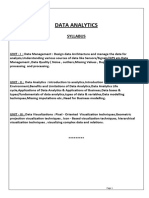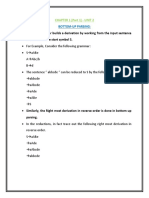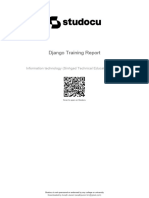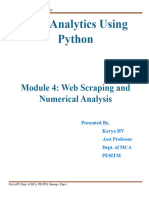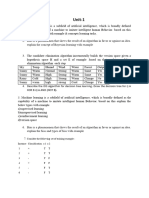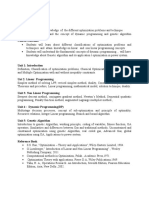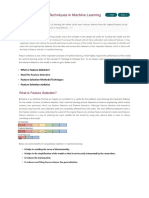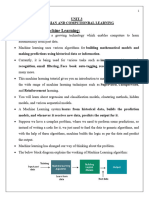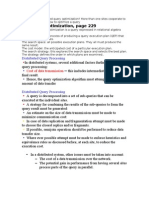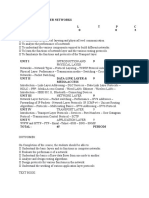Page 1: Introduction to Django
Description: This page provides an overview of Django, explaining what it is and
why it is a popular web development framework. It guides you through the
process of installing Django and setting up a new Django project. You'll also
explore the basic structure of a Django project.
Content:
What is Django?
Advantages of using Django
Installing Django
Setting up a new Django project
Exploring the project structure
Page 2: Django Models and Databases
Description: This page introduces Django models, which are Python classes that
represent database tables. You'll learn how to create models and generate
corresponding database tables. The concept of relationships between models,
such as one-to-one, one-to-many, and many-to-many, is explained. You'll also
discover how to perform basic CRUD operations (Create, Retrieve, Update,
Delete) with models.
Content:
Understanding Django models
Defining models and fields
Generating database tables
Model relationships (one-to-one, one-to-many, many-to-many)
CRUD operations with models
Page 3: Django Views and URL Routing
Description: Here, you'll dive into Django views, which handle the logic of your
web application. The concept of URL routing is introduced, explaining how URLs
are mapped to views. You'll learn to work with both function-based views and
class-based views. The page covers passing data to views using URL parameters
and query strings.
Content:
Introduction to Django views
Mapping URLs to views
Function-based views
� Class-based views
Passing data to views using URL parameters and query strings
Page 4: Django Templates and User Interface
Description: This page introduces Django templates, which provide a way to
structure and present the user interface. You'll learn how to create templates and
render them within views. The concept of template inheritance is explained,
allowing you to reuse and extend templates. You'll discover how to work with
template tags and filters to perform operations and manipulate data. Handling
forms and user input in templates is also covered.
Content:
What are Django templates?
Creating and rendering templates
Template inheritance and extending templates
Template tags and filters
Handling forms and user input in templates
Page 5: Django Forms and Validation
Description: Here, you'll explore Django forms, which simplify the process of
working with HTML forms. You'll learn how to create HTML forms using Django
form classes. The page covers handling form submissions, validating form data,
and displaying form errors and messages. You'll also learn how to customize
form validation and error messages.
Content:
Introduction to Django forms
Creating forms with Django form classes
Handling form submissions
Form validation and error handling
Customizing form validation and error messages
Page 6: Django Authentication and User Management
Description: This page focuses on user authentication in Django. You'll learn how
to implement user registration and login functionality. The concept of restricting
access to views based on user authentication is explained. The page also covers
user authentication with third-party libraries, such as social login. Managing user
profiles and permissions is introduced as well.
Content:
� User authentication in Django
User registration and login
Restricting views based on authentication
Third-party authentication (social login)
Managing user profiles and permissions
Page 7: Django ORM and Querying the Database
Description: This page introduces the Django ORM (Object-Relational Mapping),
which provides an abstraction layer for interacting with databases. You'll learn
how to perform database queries using the Django ORM, including filtering,
ordering, and aggregating results. The concept of using Q objects to execute
complex queries is explained. The page also covers performing raw SQL queries
with the Django ORM and optimizing database queries.
Content:
Overview of the Django ORM
Querying the database with the ORM
Filtering, ordering, and aggregating query results
Executing complex queries with Q objects
Raw SQL queries and optimization
Page 8: Django REST Framework (DRF)
Description: This page introduces the Django REST Framework, a powerful toolkit
for building RESTful APIs. You'll learn how to create RESTful APIs using DRF and
serialize data with serializers. The page covers handling different types of API
requests, such as GET, POST, PUT, and DELETE. Authentication and permissions in
DRF are explained to secure your APIs.
Content:
Introduction to Django REST Framework
Building RESTful APIs with DRF
Serializers and data validation
Handling API requests (GET, POST, PUT, DELETE)
Authentication and permissions in DRF
Page 9: Advanced Django Concepts
Description: This page explores advanced concepts in Django. You'll learn about
Django middleware, which allows you to process requests and responses
globally. The concept of caching in Django is explained, helping improve the
� performance of your application. The page also covers internationalization and
localization for building multilingual applications. Working with file uploads and
handling static files is introduced, along with testing Django applications.
Content:
Working with Django middleware
Caching in Django
Internationalization and localization
File uploads and handling static files
Testing Django applications
Page 10: Deployment and Production Considerations
Description: The final page focuses on preparing a Django application for
production. It covers considerations such as configuring the production
environment, optimizing performance and scalability, hosting options for Django
applications, and monitoring and error tracking in production.
Content:
Preparing a Django application for production
Configuring the production environment
Optimizing performance and scalability
Hosting options for Django applications
Monitoring and error tracking in production


